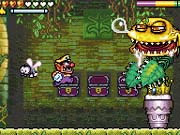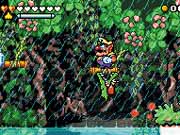Wario Land 4 Preview
Wario is back and looking better than ever on the Game Boy Advance. Read our hands-on impressions of the final Japanese copy of this handheld platforming game.
Previous Wario games have been so successful on the Game Boy Color that Nintendo has never felt the need to give Mario's archnemesis his own 3D game. Considering how impressive past Wario games have been, this strategy has yet to meet with complaints. Now that Nintendo has sent the Game Boy Color out to pasture, it has decided to continue the series in 2D on its newest handheld platform, the Game Boy Advance. Wario Land 4, the latest game in the series, was recently released in Japan. And after we played it incessantly for weeks, it's apparent that Nintendo hasn't lost the ability to design and develop a quality 2D platformer in the era of 3D games.

Wario Land 4 begins with Wario learning that a new pyramid has recently been discovered. Never one to pass on plundering treasure, Wario jumps in his car and strikes out to find the pyramid and rob it of its riches. The pyramid is split into four main sections. Within each of the four sections, four levels and a boss lie in wait. The object of each level is to collect four pieces of stone, flip a switch, and then retreat to the beginning of the level before a timer expires. If you capture a key-holding ghost before flipping the switch and then safely return to the entrance, the next level of the pyramid section will be open for play. To fight the boss from each section of the pyramid, you must collect all four pieces of each stone in each of the section's four levels, for a grand total of 16 stone pieces. Cleverly hidden CDs may also be collected and then used in the game's sound test menu. One of the biggest changes for Wario Land 4 when compared with previous installments is that Wario can now die. His health is measured in heart containers, and when they become depleted, he is kicked out of the level and must begin again. It can be frustrating to collect all four stone pieces in a level, only to die and lose them all.
Wario has a history of being able to perform a multitude of moves in his games, and Wario Land 4 is no different. Wario can attack, dash, butt-stomp, swim, throw objects, and roll all on his own. However, certain enemies will cause Wario to change forms once he's been attacked. Wario will turn into a bat, allowing him to fly; a jumping jack, allowing him to spring to high ledges; a balloon, which supplies him with the ability to float; and a zombie, which facilitates evaporating and falling through platforms. Wario will take 10 different forms throughout the game, and the levels are designed to take advantage of his various mutations. Many of the game's sections require some inductive reasoning and inventive manipulation of the environment. The puzzles are sometimes difficult, but the end result often justifies the means. In addition to the traditional platforming elements the series is known for, there's a series of minigames, which serve as a nice distraction. One minigame is a simplistic home run derby that requires you to turn the Game Boy Advance on its side to play. Another minigame is reminiscent of Mr. Potato Head in that you must match the eyes, nose, and mouth of a character that briefly flashes onscreen. The final minigame has Wario running on a barrel. Similar to the vehicle in the arcade classic Moon Patrol, Wario must jump cacti, rocks, pigs, and other obstacles in hopes of reaching the end.

Nintendo's Game Boy Advance games haven't exactly pushed the system's graphical limits thus far, but Wario Land 4 is an exception to this pattern. Each of the game's almost 20 levels has its own unique art style, and each one is visually impressive in its own right. Some levels have the flat, pastel-shaded look of old-school 2D Mario games, while others feature dingy environments complete with rainfall and sterile steel surroundings with moving machinery parts. Transparencies are used especially well to demonstrate drifting fog, ghastly enemies, and a variety of liquid substances. Several sections of Wario Land 4 require that Wario roll into a ball and jettison through the stages. In these instances, the scrolling lag never becomes a problem. Perhaps most importantly, Wario Land 4's graphics are bright enough that it can be played in less-than-ideal lighting conditions.
As good as the level design and graphics are, they pale in comparison to the sound. There are nearly a dozen different tracks included in the game, complete with lyrics, and they'll build in intensity when the time is right. Voice samples are also plentiful. Wario has well more than a dozen different sayings, and many of the characters he encounters have their own battle cries or commentary. The sound effects are also quite good--it's easy to forget that you're listening to a handheld game.
Wario Land 4, even in its Japanese incarnation, is one of the Game Boy Advance's better games. The level design is inventive and the gameplay is varied--overall, the game is solid from a technical perspective. If you've been waiting for the next great 2D platforming game from Nintendo, keep a close watch on Wario Land 4 as its November release date in North America approaches.
Got a news tip or want to contact us directly? Email news@gamespot.com
Join the conversation